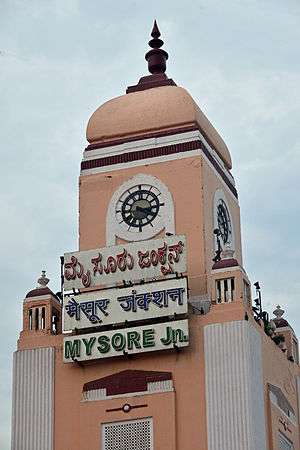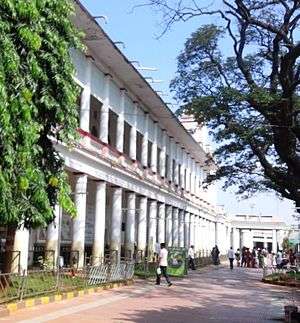Mysore–Bangalore railway line
| Mysore–Bangalore railway line | |||||||||||||||||||||||||||||||||||||||||||||||||||||||||||||||||||||||||||||||||||||||||||||||||||||||||||||||||||||||||||||||||||||||||||||||||||||||||||||||||||||||||||||||||||||||
|---|---|---|---|---|---|---|---|---|---|---|---|---|---|---|---|---|---|---|---|---|---|---|---|---|---|---|---|---|---|---|---|---|---|---|---|---|---|---|---|---|---|---|---|---|---|---|---|---|---|---|---|---|---|---|---|---|---|---|---|---|---|---|---|---|---|---|---|---|---|---|---|---|---|---|---|---|---|---|---|---|---|---|---|---|---|---|---|---|---|---|---|---|---|---|---|---|---|---|---|---|---|---|---|---|---|---|---|---|---|---|---|---|---|---|---|---|---|---|---|---|---|---|---|---|---|---|---|---|---|---|---|---|---|---|---|---|---|---|---|---|---|---|---|---|---|---|---|---|---|---|---|---|---|---|---|---|---|---|---|---|---|---|---|---|---|---|---|---|---|---|---|---|---|---|---|---|---|---|---|---|---|---|---|
|
Mysore Junction | |||||||||||||||||||||||||||||||||||||||||||||||||||||||||||||||||||||||||||||||||||||||||||||||||||||||||||||||||||||||||||||||||||||||||||||||||||||||||||||||||||||||||||||||||||||||
| Overview | |||||||||||||||||||||||||||||||||||||||||||||||||||||||||||||||||||||||||||||||||||||||||||||||||||||||||||||||||||||||||||||||||||||||||||||||||||||||||||||||||||||||||||||||||||||||
| Status | Operational | ||||||||||||||||||||||||||||||||||||||||||||||||||||||||||||||||||||||||||||||||||||||||||||||||||||||||||||||||||||||||||||||||||||||||||||||||||||||||||||||||||||||||||||||||||||||
| Locale | Karnataka | ||||||||||||||||||||||||||||||||||||||||||||||||||||||||||||||||||||||||||||||||||||||||||||||||||||||||||||||||||||||||||||||||||||||||||||||||||||||||||||||||||||||||||||||||||||||
| Termini |
Mysore Junction (MYS) Bangalore City (SBC) | ||||||||||||||||||||||||||||||||||||||||||||||||||||||||||||||||||||||||||||||||||||||||||||||||||||||||||||||||||||||||||||||||||||||||||||||||||||||||||||||||||||||||||||||||||||||
| Stations | 24 | ||||||||||||||||||||||||||||||||||||||||||||||||||||||||||||||||||||||||||||||||||||||||||||||||||||||||||||||||||||||||||||||||||||||||||||||||||||||||||||||||||||||||||||||||||||||
| Services | 1 | ||||||||||||||||||||||||||||||||||||||||||||||||||||||||||||||||||||||||||||||||||||||||||||||||||||||||||||||||||||||||||||||||||||||||||||||||||||||||||||||||||||||||||||||||||||||
| Website |
www | ||||||||||||||||||||||||||||||||||||||||||||||||||||||||||||||||||||||||||||||||||||||||||||||||||||||||||||||||||||||||||||||||||||||||||||||||||||||||||||||||||||||||||||||||||||||
| Operation | |||||||||||||||||||||||||||||||||||||||||||||||||||||||||||||||||||||||||||||||||||||||||||||||||||||||||||||||||||||||||||||||||||||||||||||||||||||||||||||||||||||||||||||||||||||||
| Opened | February 25, 1882 | ||||||||||||||||||||||||||||||||||||||||||||||||||||||||||||||||||||||||||||||||||||||||||||||||||||||||||||||||||||||||||||||||||||||||||||||||||||||||||||||||||||||||||||||||||||||
| Owner | Indian Railway | ||||||||||||||||||||||||||||||||||||||||||||||||||||||||||||||||||||||||||||||||||||||||||||||||||||||||||||||||||||||||||||||||||||||||||||||||||||||||||||||||||||||||||||||||||||||
| Operator(s) | South Western Railway zone | ||||||||||||||||||||||||||||||||||||||||||||||||||||||||||||||||||||||||||||||||||||||||||||||||||||||||||||||||||||||||||||||||||||||||||||||||||||||||||||||||||||||||||||||||||||||
| Depot(s) | Krishnarajapuram | ||||||||||||||||||||||||||||||||||||||||||||||||||||||||||||||||||||||||||||||||||||||||||||||||||||||||||||||||||||||||||||||||||||||||||||||||||||||||||||||||||||||||||||||||||||||
| Rolling stock |
WDM-2 WDM-3A WDP-4D WDP-4 WDG-3A WDG-4 | ||||||||||||||||||||||||||||||||||||||||||||||||||||||||||||||||||||||||||||||||||||||||||||||||||||||||||||||||||||||||||||||||||||||||||||||||||||||||||||||||||||||||||||||||||||||
| Technical | |||||||||||||||||||||||||||||||||||||||||||||||||||||||||||||||||||||||||||||||||||||||||||||||||||||||||||||||||||||||||||||||||||||||||||||||||||||||||||||||||||||||||||||||||||||||
| Line length | 138.25 kilometres (85.90 mi) | ||||||||||||||||||||||||||||||||||||||||||||||||||||||||||||||||||||||||||||||||||||||||||||||||||||||||||||||||||||||||||||||||||||||||||||||||||||||||||||||||||||||||||||||||||||||
| Number of tracks | 1 | ||||||||||||||||||||||||||||||||||||||||||||||||||||||||||||||||||||||||||||||||||||||||||||||||||||||||||||||||||||||||||||||||||||||||||||||||||||||||||||||||||||||||||||||||||||||
| Track gauge | 1,676 mm (5 ft 6 in) | ||||||||||||||||||||||||||||||||||||||||||||||||||||||||||||||||||||||||||||||||||||||||||||||||||||||||||||||||||||||||||||||||||||||||||||||||||||||||||||||||||||||||||||||||||||||
| Old gauge | 1,000 mm (3 ft 3 3⁄8 in) | ||||||||||||||||||||||||||||||||||||||||||||||||||||||||||||||||||||||||||||||||||||||||||||||||||||||||||||||||||||||||||||||||||||||||||||||||||||||||||||||||||||||||||||||||||||||
| Loading gauge | 4,725 mm × 3,660 mm (15 ft 6.0 in × 12 ft 0.1 in) (BG)[1] | ||||||||||||||||||||||||||||||||||||||||||||||||||||||||||||||||||||||||||||||||||||||||||||||||||||||||||||||||||||||||||||||||||||||||||||||||||||||||||||||||||||||||||||||||||||||
| Operating speed | 37 km/h (23 mph) | ||||||||||||||||||||||||||||||||||||||||||||||||||||||||||||||||||||||||||||||||||||||||||||||||||||||||||||||||||||||||||||||||||||||||||||||||||||||||||||||||||||||||||||||||||||||
| Route number | 74[2] | ||||||||||||||||||||||||||||||||||||||||||||||||||||||||||||||||||||||||||||||||||||||||||||||||||||||||||||||||||||||||||||||||||||||||||||||||||||||||||||||||||||||||||||||||||||||
| |||||||||||||||||||||||||||||||||||||||||||||||||||||||||||||||||||||||||||||||||||||||||||||||||||||||||||||||||||||||||||||||||||||||||||||||||||||||||||||||||||||||||||||||||||||||
Mysore–Bangalore railway line is a railway line from Mysore Junction to Bangalore City.
Background
The line extends from Mysore Junction to Bangalore City falling mostly under Bangalore railway division and a few stretches under Mysore railway division within the limits of South Western Railway zone headquartered at Bangalore City railway station.[3][4]
Construction
Since the rail network in British India was entirely private affairs. The erstwhile Kingdom of Mysore established Mysore State Railway for improving rail connectivity, right after the commissioning of Madras Royapuram–Bangalore City railway line in 1879.[5] Though managing Mysore State Railway was an expensive affair, Chamarajendra Wadiyar X decided to lay a new rail from Bangalore to Mysore in 1870, and shelved the project soon.[6] Again he dusted the project and initiated the construction in 1877–1878. The 56 kilometres (35 mi) stretch between Bangalore–Channapatna was completed in 1 February 1881, the 37 kilometres (23 mi) Channapatna–Mandya stretch in 20 March 1881 and the final 45 kilometres (28 mi) Mandya–Mysore stretch was completed and the entire stretch thrown open to traffic on 25 February 1882.[7][8]
Development
Sanctioned in 2009–2010, the railways took up the state's demand for doubling as well electrification at an estimated cost of ₹505 crore (US$75 million) which was later revised to ₹526.31 crore (US$78 million) and finally escalated to ₹874.75 crore (US$130 million). As only the 12 kilometres (7.5 mi) Bangalore City–Kengeri stretch been completed, the work for the rest of line is in progress. Land acquisition of about 160 acres (65 ha), especially 25 acres (10 ha) near Mandya alone have been done as part of double line and improving stations between Ramanagaram and Mysore Junction.[9]
Stations en route
- Mysore Junction
- Naganahalli
- Shrirangapattana
- Pandavapura
- Chandagiri Koppal
- Byandara Halli
- Yeliyur
- Mandya
- Maddur
- Settihally
- Channapatna
- Ramanagara
- Hejjala
- Kengeri
- Jnanabharati Halt
- Nayandahalli
- Bangalore City
Image gallery
-

Train Schedule at Bangalore
-

Srirangapattana
-

Bangalore
-

Train timings
-

Mysore junction
References
- ↑ J S Mundrey (2010). Railway Track Engineering (Fourth ed.). New Delhi: Tata McGraw Hill. p. 7. ISBN 978-0-07-068012-8. Retrieved 4 October 2016.
- ↑ "Public Time Table" (PDF). South Western Railway zone. Indian Railways. 246. Retrieved 4 October 2016.
- ↑ "Zones and their Divisions in Indian Railways" (PDF). Indian Railways. Retrieved 4 October 2016.
- ↑ "South Western Railway zone". Railway Board. South Western Railway zone. Retrieved 4 October 2016.
- ↑ Saritha, S R (6 November 2013) [Completed 2012]. "2" (PDF). Colonialism and modernisation;history and development of southern railway a case study (Ph.D.,). University of Kerala. pp. 64–65. Retrieved 5 October 2016.
- ↑ "A rail link to Mysore's history". The Times of India. Mysore. 19 February 2012. Retrieved 5 October 2016.
- ↑ Shankaragouda Hanamantagouda Patil, S. H. Patil ; foreword by M .M. Kalburgi (2002). Community dominance and political modernisation. New Delhi: Mittal Publications. p. 61. ISBN 9788170998679. Retrieved 5 October 2016.
- ↑ R. Krishna, Kumar (27 April 2013). "History unfolds". The Hindu. Retrieved 5 October 2016.
- ↑ Asha, Krishnaswamy (15 June 2015). "Railway double line to Mysuru almost ready". Deccan Herald. Retrieved 5 October 2016.
